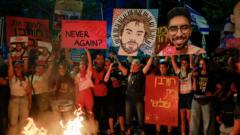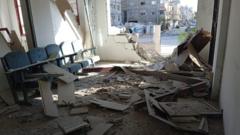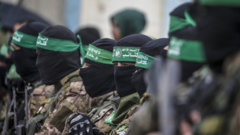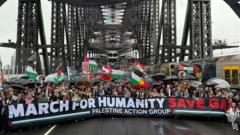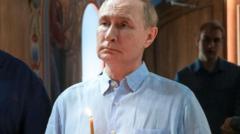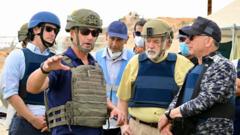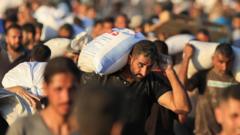Following a ceasefire in Gaza, rescue workers estimate over 10,000 bodies remain buried under debris, while aid flows into the region; the UN warns of a long road to recovery after widespread devastation has left millions homeless and dependent on aid.
Gaza's Reconstruction Challenges Begin Post-Ceasefire
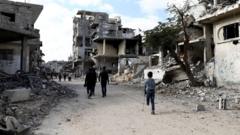
Gaza's Reconstruction Challenges Begin Post-Ceasefire
In the aftermath of a devastating 15-month conflict, Gaza faces an enormous humanitarian crisis, as rescue efforts struggle against the profound destruction and loss of life.
In the wake of a hard-fought ceasefire, the dire situation in Gaza is beginning to unravel as rescue workers and residents confront the massive scale of destruction that persists in the region. The Civil Defence agency, responsible for emergency responses, has made alarming claims, suggesting that over 10,000 bodies may still be trapped under the rubble of flattened buildings and homes. Mahmoud Basal, a spokesperson for the agency, voiced concerns over the looming recovery efforts, noting that despite hopes to recover deceased individuals within a span of 100 days, they are now hindered by insufficient equipment such as bulldozers.
Recent images depicting the aftermath of the 15-month-long Israeli offensive highlight scenes of utter ruin, particularly in the northern areas of Gaza. Prior to the ceasefire, the United Nations had estimated that approximately 60% of structures in the enclave suffered significant damage or complete destruction. Even though the sounds of bombardments have ceased and celebrations erupted with the ceasefire announcement, the stark reality of survival in Gaza is grim. The UN World Food Programme has reported that more than two million residents are now homeless and rely entirely on food aid.
As humanitarian assistance began streaming into Gaza following the ceasefire, over 630 trucks delivered much-needed supplies the first day alone. This figure grew exponentially on the second day, with UN reports confirming an additional 915 trucks entered, marking the highest rate of aid deliveries since the conflict escalated.
Sam Rose, the acting director of UNRWA, emphasized the magnitude of the recovery that lies ahead, addressing the multifaceted needs of the population. "We're not just talking about food, healthcare, buildings, roads, infrastructure – we are dealing with individuals and families that need to be rebuilt," he said. The scars of trauma endured by the population pose challenges that extend beyond physical reconstruction.
In Israel, families of freed hostages have shared poignant stories, expressing relief over their loved ones’ return, albeit with concern for others still missing. Footage was released showing hostages tearfully reuniting with family members. Amidst the hope of more hostages being released, fears loom over the possibility of the ceasefire collapsing, as Israeli officials maintain military options.
Amid the recovery, grim reports from Palestinian health authorities indicate more than 46,900 lives have been lost and over 110,700 people have been wounded during the conflict, predominantly affecting women and children. An analysis by a UK-led study has suggested that the actual death toll could be substantially higher than reported.
With the Israeli military beginning its retreat from densely populated areas, there are risk factors for displaced individuals as they attempt to assess the damage to their homes. Many residents, eager to return, are navigating the delicate balance of safety and the need to uncover what remains of their lives. Hatem Eliwah, a resident of Gaza City, expressed hope despite personal losses: "We have been waiting for this ceasefire like people waiting to enter heaven."
However, concerns and warnings from UN Secretary-General Antonio Guterres regarding stability in the region remind international observers of the fragile status quo, especially with increasing tensions in the occupied West Bank resembling a boiling point. The road to recovery in Gaza is fraught with challenges as the community grapples with loss while trying to reclaim a semblance of normalcy amid the ruins.
Recent images depicting the aftermath of the 15-month-long Israeli offensive highlight scenes of utter ruin, particularly in the northern areas of Gaza. Prior to the ceasefire, the United Nations had estimated that approximately 60% of structures in the enclave suffered significant damage or complete destruction. Even though the sounds of bombardments have ceased and celebrations erupted with the ceasefire announcement, the stark reality of survival in Gaza is grim. The UN World Food Programme has reported that more than two million residents are now homeless and rely entirely on food aid.
As humanitarian assistance began streaming into Gaza following the ceasefire, over 630 trucks delivered much-needed supplies the first day alone. This figure grew exponentially on the second day, with UN reports confirming an additional 915 trucks entered, marking the highest rate of aid deliveries since the conflict escalated.
Sam Rose, the acting director of UNRWA, emphasized the magnitude of the recovery that lies ahead, addressing the multifaceted needs of the population. "We're not just talking about food, healthcare, buildings, roads, infrastructure – we are dealing with individuals and families that need to be rebuilt," he said. The scars of trauma endured by the population pose challenges that extend beyond physical reconstruction.
In Israel, families of freed hostages have shared poignant stories, expressing relief over their loved ones’ return, albeit with concern for others still missing. Footage was released showing hostages tearfully reuniting with family members. Amidst the hope of more hostages being released, fears loom over the possibility of the ceasefire collapsing, as Israeli officials maintain military options.
Amid the recovery, grim reports from Palestinian health authorities indicate more than 46,900 lives have been lost and over 110,700 people have been wounded during the conflict, predominantly affecting women and children. An analysis by a UK-led study has suggested that the actual death toll could be substantially higher than reported.
With the Israeli military beginning its retreat from densely populated areas, there are risk factors for displaced individuals as they attempt to assess the damage to their homes. Many residents, eager to return, are navigating the delicate balance of safety and the need to uncover what remains of their lives. Hatem Eliwah, a resident of Gaza City, expressed hope despite personal losses: "We have been waiting for this ceasefire like people waiting to enter heaven."
However, concerns and warnings from UN Secretary-General Antonio Guterres regarding stability in the region remind international observers of the fragile status quo, especially with increasing tensions in the occupied West Bank resembling a boiling point. The road to recovery in Gaza is fraught with challenges as the community grapples with loss while trying to reclaim a semblance of normalcy amid the ruins.

